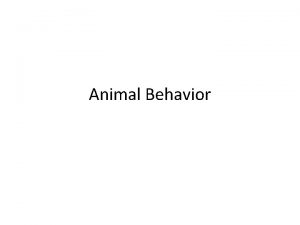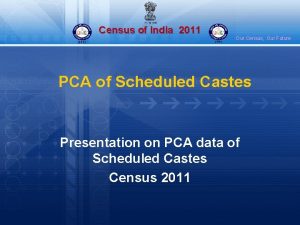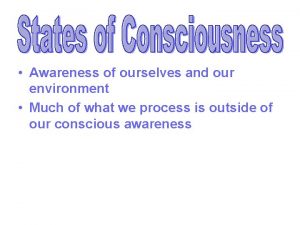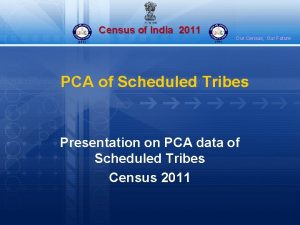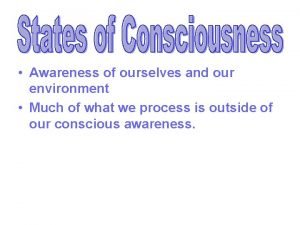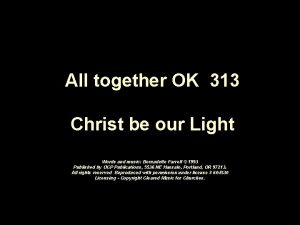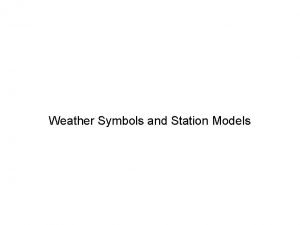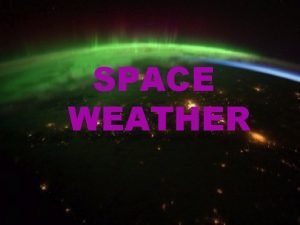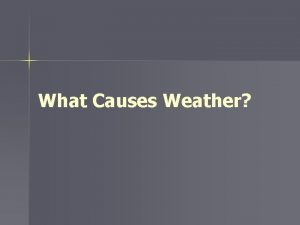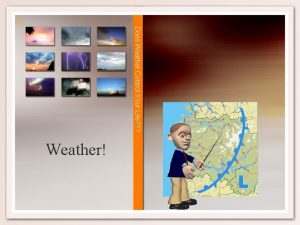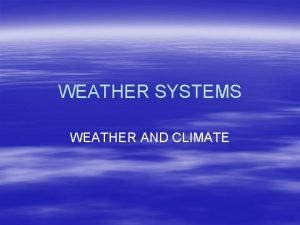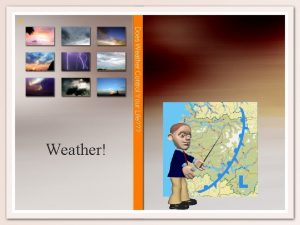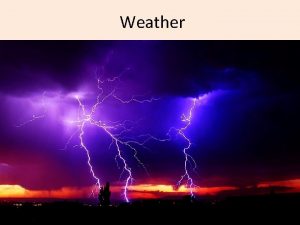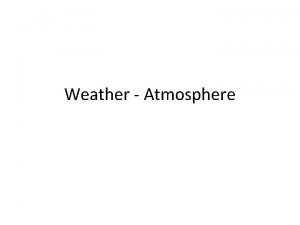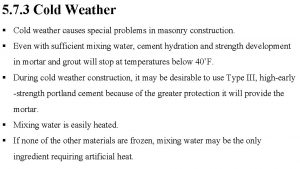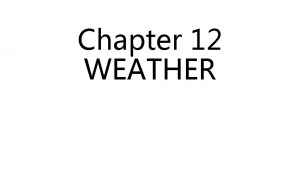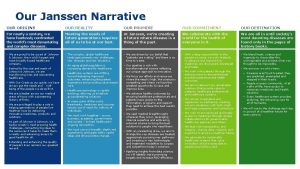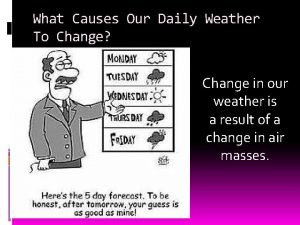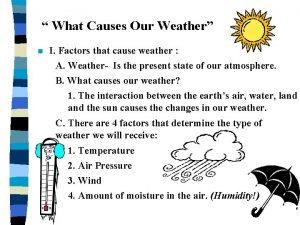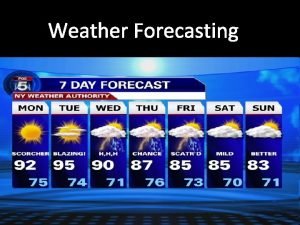I What Causes Our Weather 1 Weather Is


















- Slides: 18

“ I. What Causes Our Weather” 1. Weather- Is the present state of our atmosphere. 2. The interaction between the earth’s air, water, land the sun causes the changes in our weather. A. There are 4 specific factors that change our weather from day to day: 1. Temperature 2. Air Pressure 3. Wind 4. Amount of moisture in the air. (Humidity!)

n II. Heat Transfer on Earth : 1. The way the earth is heated controls many characteristics of the atmosphere. A. Heat moves through earth in three different ways: 1. Radiation 2. Conduction 3. Convection B. Radiation: 1. Energy that comes off of the sun and is absorbed by the earth. 2. When a surface on earth comes into contact with this radiation it either absorbs it or deflects it away. 3. If it absorbs it the surface will change it into heat.

C. Conduction: 1. The transfer of heat when molecules collide into each other. 2. Molecules in hot objects move toward the molecules in cold objects. 3. Heat is transferred to the colder object until the molecules are all the same temperature. 4. Ex. Frying pan on a stove. D. Convection: 1. The transfer of heat through convection currents. (Only through a fluid) 2. Hot molecules are less dense than cold molecules. 3. A hot fluid will rise and a cold fluid will sink. 4. This causes convection currents. 5. Ex. Water boiling on a stove.

n III. Air Pressure: 1. Air Pressure- The weight of the atmosphere as it pushes down on earth’s surface. A. Three factors determine air pressure: B. Temperature of the air. 1. ) The higher the temperature, the lower the air pressure. C. Density of the air. (Elevation) 1. ) The higher the density, the higher the pressure. D. The amount of water vapor. (Humidity) 1. ) The higher the humidity, the lower the pressure.

n IV: Wind: 1. The movement of air due to air pressure changes and the rotation of the earth. A. Why do we get different wind systems? 1. Air Pressure changes 2. Coriolis Effect B. Air Pressure Changes: 1. Uneven heating of the earth causes different air temperatures. 2. That can change the air pressure. 3. Wind blows from areas of high pressure to areas of low pressure.

C. Coriolis Effect: 1. This also will affect wind systems. 2. Coriolis Effect-Is the result of the earth’s eastward rotation. 3. It pushes winds in the northern hemisphere to the right (clockwise), and to the left (counter clockwise) in the southern hemisphere.

V. Different Wind Systems: 1. There are three types of winds: 2. Global, Local, & Monsoon Winds. 3. Winds are named for the direction they blow from. A. Major or Global Winds: 1. ) Doldrums- Windless zone of the earth that is located in the 0 to 5 degree “Northeast or latitudes. Southeast 2. ) Trade Winds- Blow from east to west and are Trade located between 5 to 30 degrees Winds” North or South latitude. 3. ) Prevailing Westerlies-Blow from west to east located between 30 to 60 Responsible for our degrees north or south weather. latitude. 4. ) Polar Easterlies- Blow from east to west and are located between 60 to 90 degrees north or south latitude.


B. Minor or Local Wind Systems: 1. Earth also has some local wind systems 2. that affect our weather. C. Jet Stream- Narrow belts of strong winds in the upper troposphere. 1. ) There are two jet streams in each hemisphere. 2. ) They can change position daily. 3. ) When they do they have a major influence on weather. D. Sea Breeze- Cold winds blowing from the water to the land. 1. ) It is a convection current of wind caused by the land warming faster during the day than the water does.



E. Land Breeze- Cold winds blowing from the land to the water. 1. ) It is a convection current of wind caused by the land cooling faster at night than water does. F. Monsoon Winds: 1. Monsoon winds- Sea or land breezes that cover a large area and change direction with the seasons. G. Types & Locations of Monsoon winds: 1. ) Summer Monsoon- Large sea breezes that bring a season of heavy rain. 2. ) Winter Monsoon- Large land breezes that bring a season of very dry weather. 3. ) Common Monsoon locations are South East Asia (India), West Africa, and North Eastern South America.


n VI. The amount of Moisture in the Air: Continuous movement of water between the atmosphere and the surface. 2. The amount of water in the atmosphere continully changes due to this water cycle. 1. Water Cycle- A. Steps of the Water Cycle: 1. Water starts off in oceans, lakes, rivers, glaciers, etc. 2. It then evaporates. * Evaporation- The process of liquids turning to gas. 3. Then the gas condenses. * Condensation- The process of a gas turning into a liquid.


4. When clouds of water become to heavy, the water precipitates back to earth. * Precipitation- Water drops that fall from the clouds because the clouds could no longer support them. 5. Precipitation then replaces water that has already evaporated. * Ground Water & - Replaces the water that has evaporated. Runoff B. Measuring water in the air: 1. There are two types of water vapor measures. 2. Humidity- The amount of water in the air. 3. Relative Humidity-Compares the actual amount of water vapor in the air with the maximum amount of water vapor the air can hold.

not * Relative humidity is expressed as a %. * If the relative humidity is 100 % the air can hold any more water. C. Water in the air: 1. ) Air acts like a sponge. 2. ) Holes in the sponge allow it to hold water. 3. ) Air holds water in a similar way. 4. ) Water fits into the spaces between the molecules of air. 5. ) When the air can’t hold any more water clouds start to form.

D. Saturation & Dew Point: 1. Saturation-When air contains as much moisture as possible. 2. Additional water added to the air will condense back to a liquid and form clouds. 3. Dew Point- The temperature at which air is saturated and water vapor in the air condenses. E. Two things determine relative humidity: 1. Temperature of the air. * Warm air can hold more moisture than cold air. 2. The amount of moisture added or subtracted into an area. * ex. Bathroom after a shower. 3. When will relative humidity be the highest? * Cold temperatures. * High Water levels in the air.
 Proximate causation vs ultimate causation
Proximate causation vs ultimate causation Proximate and ultimate behavior examples
Proximate and ultimate behavior examples Our future is in our hands quotes
Our future is in our hands quotes We bow our hearts we bend our knees
We bow our hearts we bend our knees Awareness of ourselves and our environment is
Awareness of ourselves and our environment is Our census our future
Our census our future Our awareness of ourselves and our environment.
Our awareness of ourselves and our environment. Awareness of ourselves and our environment
Awareness of ourselves and our environment Our census our future
Our census our future Our awareness of ourselves and our environment is called
Our awareness of ourselves and our environment is called Ok 313
Ok 313 Our life is what our thoughts make it
Our life is what our thoughts make it God our father christ our brother
God our father christ our brother Marcus aurelius our life is what our thoughts make it
Marcus aurelius our life is what our thoughts make it Money madness is written by
Money madness is written by Thinking affects our language which then affects our
Thinking affects our language which then affects our Cpalms what causes weather
Cpalms what causes weather Sequencers grammar
Sequencers grammar Station model symbols
Station model symbols
